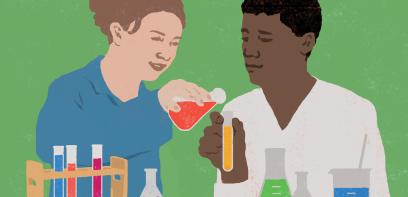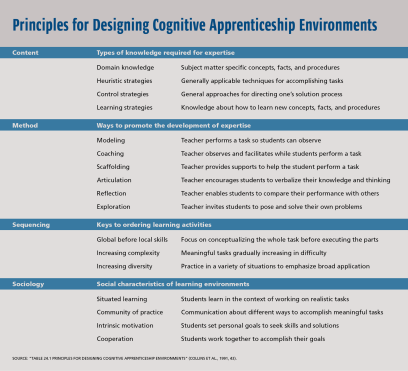For educators seeking research findings written in a clear and engaging manner to enhance their instruction, How Learning Happens: Seminal Works in Educational Psychology and What They Mean in Practice is an invaluable resource. The book by Paul A. Kirschner and Carl Hendrick examines 28 significant works published over the past six decades on effective teaching and learning. Each chapter is devoted to a specific article, with not only a discussion of the original article but also what the research means for education and teaching in general, how teachers can use the work in their own specific teaching, takeaways for the classroom, and suggested readings and videos with handy QR-codes to access them. The topics run the gamut from information processing to attribution theory to dual coding to feedback.
One such work is “Cognitive Apprenticeship: Making Thinking Visible,” an article first published in American Educator in 1991 and available for free here. Written by Allan Collins, John Seely Brown, and Ann Holum, the work explains how the traditional apprenticeship model, which enabled an apprentice to actually “see the processes of work,” offers insights for formal schooling. Among them is the need for educators to make their thinking transparent so that students gain subject matter knowledge, practice their skills with teacher support, and eventually learn on their own.
Here, we excerpt chapter 24 of How Learning Happens. Aptly titled “Making Things Visible,” the chapter summarizes key points from “Cognitive Apprenticeship” and what educators can continue to learn from it.
–EDITORS
Beginning in the late Middle Ages and up through the beginning of the twentieth century, it was perfectly normal for children to get an education or be trained in a profession by being apprenticed to masters in their workplace. This was part of what is known as the guild system where experienced and confirmed experts in a field or craft (i.e., master craftsmen) hired new employees who began as apprentices and received their education or training in exchange for food, lodging, and, of course, work.
The apprentice began by observing the master craftsman at work—for example a weaver, blacksmith, or printer—and learned to look and practice under her or his (almost always his) tutelage. The training was mostly about practical actions; the usefulness of what had to be learned was clear, and there were clearly defined end products such as a cloth or tapestry, a knife, or a book. Also, the learning environment was social.
Today, most children learn in schools with the teacher replacing the master craftsman, though some schools and professions still make use of at least part of the apprenticeship approach (such as vocational high schools or even medical colleges). Also, most learning materials and assignments are now more abstract and independent of the context in which they’ll ultimately be used. As a result, unless the teacher uses modeling, for example, as an educational approach, students may not have a good idea of how to carry out their assignments as they can no longer copy how an expert works and thinks.
In their article, Allan Collins, John Seely Brown, and Ann Holum make a case for a form of instruction that resembles the former master–apprenticeship relationship. They call this method of instruction cognitive apprenticeship and describe it as follows:1
While there are many differences between schooling and apprenticeship methods, we will focus on one. In apprenticeship, students can see the processes of work: They watch a parent sow, plant, and harvest crops and help as they are able; they assist a tradesman as he crafts a cabinet; they piece together garments under the supervision of a more experienced tailor. Apprenticeship involves learning a physical, tangible activity. But in schooling, the “practice” of problem solving, reading comprehension, and writing is not at all obvious—it is not necessarily observable to the student. In apprenticeship, the processes of the activity are visible. In schooling, the processes of thinking are often invisible to both the students and the teacher. Cognitive apprenticeship is a model of instruction that works to make thinking visible.
For learners to learn something, it’s necessary for the teacher to make the reasoning and strategies needed to perform a task explicit. Otherwise, many students may learn to solve these specific assignments, but do so as a trick they learn by heart. As a result, they won’t get a grip on the required thinking processes and they’ll have difficulty deploying what they have learned, with respect to both content and strategies, in different contexts. The key to overcoming this is what Collins and his colleagues call making thinking visible.
But how do you make thinking visible? First, the authors say, we need to know what learners need in order to do a task and how we can transfer it. Cognitive strategies are central to the integration of skills and knowledge and certainly to abstract knowledge areas such as reading, writing, and arithmetic. These strategies are, in their view, best communicated through contemporary apprenticeship education: learners should see from an expert (teacher or more advanced fellow student) and hear how they solve the task, which strategies the expert uses, and why. The student can then practice under supervision.
The Apprenticeship Experience
The authors write that in “traditional apprenticeship, the expert shows the apprentice how to do a task, watches as the apprentice practices portions of the task, and then turns over more and more responsibility until the apprentice is proficient enough to accomplish the task independently.”2 The authors see four critical aspects of traditional apprenticeship—modeling, scaffolding, fading, and coaching—which are also applicable to cognitive apprenticeship. In modeling an expert demonstrates the different parts of the to-be-learned behavior. In cognitive apprenticeship, this is accompanied by experts explicitly explaining what they are thinking and why they are doing certain things while carrying out a task (i.e. thinking aloud). Scaffolding is the support and guidance the teacher provides while the students are carrying out the behavior. As the students proceed, the support and guidance are slowly removed—faded—as the students become able to carry out the task themselves. This increases the independence and responsibility of the students. Finally, coaching is the “thread running through the entire apprenticeship experience”;3 the expert diagnoses encountered problems, provides feedback, and generally oversees the learning.
The interplay of all four of these aspects aids students in developing self-monitoring and correction skills as well as in integrating the conceptual knowledge and skills needed to look critically at their own progress and learn further. In all of this, observation is critical. By seeing experts carrying out authentic whole tasks, students build conceptual models of the task: they see the entire task before getting started and follow the progress of all of its constituent parts through to its completion. As a result, they don’t endlessly practice isolated skills without seeing the bigger picture.
Since teaching and learning take place mostly in schools (unlike apprenticeships in the real world with real tasks), the model of traditional apprenticeship needs to be translated to cognitive apprenticeship for three reasons. First, in traditional apprenticeship the process of carrying out a learning task is usually easily observable. In cognitive apprenticeship, however, we need to deliberately make the thinking involved in carrying out more abstract school tasks visible. “By bringing these tacit processes into the open, students can observe, enact, and practice them with help from the teacher and from other students.”4
Second, while in traditional apprenticeship tasks come up in the same way as they do in the real world, in the school, teachers are working with a curriculum that is “divorced from what students and most adults do in their lives. In cognitive apprenticeship, then, the challenge is to situate the abstract tasks of the school curriculum in contexts that make sense to students.”5
Finally, in traditional apprenticeship, the skills that need to be learned are specific to the tasks themselves. A carpenter learns to make a table leg, but doesn’t need to learn to make a buttonhole or a bookbinding. This isn’t the case in school, where students need to be able to transfer what they learn to other tasks and areas. In cognitive apprenticeship, teachers need to “present a range of tasks, varying from systematic to diverse, and to encourage students to reflect on and articulate the elements that are common across tasks.”6 To this end, Collins, Brown, and Holum note that for cognitive apprenticeship, teachers need to:7
- identify the processes of the task and make them visible to students;
- situate abstract tasks in authentic contexts, so that students understand the relevance of the work; and
- vary the diversity of situations and articulate the common aspects so that students can transfer what they learn.
A social environment (i.e., the class) is an important aspect of cognitive apprenticeship. The class offers students continuous access to examples of others at varying degrees of expertise so they can model their behavior against those others and seek advice. This way, they learn that more answers are often possible. After all, all experts will perform the task in their own ways. Moreover, they see their peers at different levels of expertise, which “encourages them to view learning as an incrementally staged process, while providing them with concrete benchmarks for their own progress.”8
In addition to offering expansive examples of cognitive apprenticeship in teaching reading, writing, and mathematics, Collins, Brown, and Holum present a framework for designing cognitive apprenticeship learning environments. This framework (shown in the table below) consists of four dimensions: content, method, sequence, and sociology.
The content should give learners a solid grounding in facts, concepts, and procedures. Having this grounding, they can learn to apply heuristics (or rules of thumb) making use of acquired control (i.e., metacognitive) strategies. Finally, students need to acquire learning strategies with which new concepts, facts, and procedures can be learned. Cognitive apprenticeship teaching methods “should be designed to give students the opportunity to observe, engage in, and invent or discover expert strategies in context.”9 The sequencing should structure learning but preserve the meaningfulness of what the learner is doing.
Finally, cognitive apprenticeship takes place in a social environment, situated in meaningful tasks, working with others. These methods come into their own in a class in which students work together with a teacher and with each other. By repeatedly articulating what they see, their thinking processes become visible, not only for themselves, but also for the teacher. In this way, the teacher knows what students can do and where they still need guidance.
The authors also note that this model can be a useful tool at certain moments in the classroom, but it certainly does not suit all forms of instruction and learning. Reading a book or watching a documentary can also be very useful ways of learning, especially when it comes to learning factual knowledge.
Paul A. Kirschner is an emeritus professor of educational psychology at the Open University of the Netherlands, a visiting professor of education at the University of Oulu in Finland, and a guest professor at Thomas More University of Applied Sciences in Belgium. Carl Hendrick is the head of learning and research at Wellington College in the United Kingdom, where he teaches English. This article is adapted from their book How Learning Happens: Seminal Works in Educational Psychology and What They Mean in Practice (Routledge, 2020). Adapted and reprinted with permission of the publisher.
Endnotes
1. A. Collins, J. S. Brown, and A. Holum, “Cognitive Apprenticeship: Making Thinking Visible,” American Educator 15, no. 3 (Winter 1991): 6-11, 38-46.
2. Collins et al., 8.
3. Collins et al., 9.
4. Collins et al., 9.
5. Collins et al., 9.
6. Collins et al., 9.
7. Collins et al., 9.
8. Collins et al., 9.
9. Collins et al., 43.
[Illustrations by Gwenda Kaczor]




